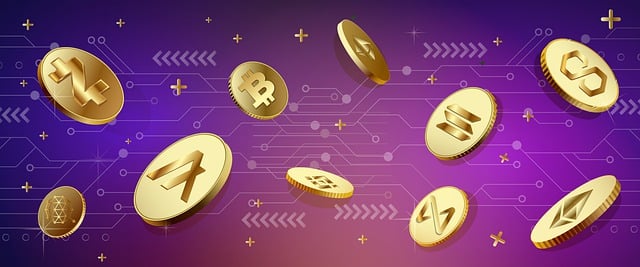Understanding Crypto Wallets: A Comprehensive Guide
In the ever-evolving world of cryptocurrency, understanding crypto wallets is essential for anyone looking to invest or trade in digital assets. This article will delve deep into the various types of crypto wallets, their functionalities, and how to choose the right one for your needs. With the rise of digital currencies, having a secure and efficient wallet can make all the difference in your crypto journey.

What is a Crypto Wallet?
A crypto wallet is a digital tool that allows users to store, send, and receive cryptocurrencies. Unlike traditional wallets that hold physical currency, crypto wallets store the public and private keys necessary to access your digital assets. Essentially, they act as a bridge between you and the blockchain, enabling you to interact with various cryptocurrencies. It is important to note that a crypto wallet does not store the actual cryptocurrency but rather the keys that allow you to access your assets on the blockchain. This distinction is crucial, as it underscores the decentralized nature of cryptocurrencies, where ownership is verified through cryptographic keys rather than physical tokens. Understanding this concept is fundamental, as it helps users grasp the importance of safeguarding their private keys, which are the only means to access and control their funds.
Types of Crypto Wallets
There are several types of crypto wallets, each with its own advantages and disadvantages. Understanding these can help you make an informed decision:
1. Hot Wallets
Hot wallets are connected to the internet and are typically used for daily transactions. They are user-friendly and accessible, making them ideal for beginners. However, their online nature makes them more vulnerable to hacks. Examples include:
- Web Wallets: Accessible through browsers, these wallets are easy to use but less secure. They often come with features such as multi-currency support and integration with exchanges, allowing for quick trades and transactions. However, users should be cautious of phishing attacks and ensure they are using reputable services. Additionally, web wallets may have limited functionalities compared to other wallet types, which can be a drawback for advanced users.
- Mobile Wallets: Apps designed for smartphones, offering convenience for on-the-go transactions. Many mobile wallets also incorporate QR code scanning for easy transactions, making them ideal for everyday use in physical stores or peer-to-peer exchanges. Some mobile wallets also provide additional features like transaction history, price alerts, and even staking options for certain cryptocurrencies, allowing users to earn passive income.
- Desktop Wallets: Software installed on personal computers, providing more security than web wallets. They allow for greater control over your private keys but require regular updates and maintenance. Desktop wallets can also offer advanced features such as built-in exchanges, portfolio tracking, and enhanced privacy options through integration with Tor or VPN services. However, they can be susceptible to malware if the computer is not adequately secured.
2. Cold Wallets
Cold wallets are offline storage solutions, making them much more secure against hacking attempts. They are ideal for long-term storage of cryptocurrencies. Types of cold wallets include:
- Hardware Wallets: Physical devices that store your keys offline, such as Ledger and Trezor. They often come with additional security features like PIN protection and recovery seed phrases. Hardware wallets are considered one of the safest options for storing large amounts of cryptocurrency, as they are immune to online threats. They also support a wide range of cryptocurrencies, making them versatile for diverse portfolios. Furthermore, many hardware wallets have user-friendly interfaces and mobile compatibility, enhancing their usability.
- Paper Wallets: Printed documents containing your keys, which must be kept safe from physical damage. While they are immune to online threats, losing or damaging the paper can result in permanent loss of access to your funds. It is advisable to create paper wallets in a secure environment and consider storing them in a safe or safety deposit box. Additionally, users should be aware of the risks of creating paper wallets on compromised devices, as malware could capture the keys during the generation process. To enhance security, consider using a dedicated offline computer to generate paper wallets.
Choosing the Right Crypto Wallet
When selecting a crypto wallet, consider the following factors:
- Security: Look for wallets that offer strong encryption and two-factor authentication. Research the wallet's reputation and any past security breaches. Understanding the wallet's security protocols can help mitigate risks associated with hacks and theft. Additionally, consider wallets that offer features like biometric authentication and multi-signature capabilities for enhanced security. Multi-signature wallets require multiple approvals for transactions, making unauthorized access significantly more challenging.
- Convenience: Choose a wallet that fits your transaction habits, whether you need quick access for daily transactions or a secure option for long-term storage. Assess how often you plan to trade or spend your cryptocurrencies. For frequent traders, a hot wallet might be more suitable, while long-term holders may prefer cold storage solutions. Additionally, consider the ease of transferring funds between wallets, especially if you plan to use multiple wallets for different purposes.
- Supported Currencies: Ensure the wallet supports the cryptocurrencies you plan to use. Some wallets are multi-currency, while others are specific to certain coins. This is particularly important if you plan to diversify your portfolio. Additionally, check for support for tokens and stablecoins that may be relevant to your investment strategy. Some wallets also offer features for managing decentralized finance (DeFi) assets, which can be beneficial for users looking to engage in yield farming or liquidity provision.
- User Experience: Evaluate the wallet's interface and ease of use. A complicated interface can lead to mistakes, especially for beginners. Look for wallets that offer tutorials or customer support to assist new users. User reviews and community feedback can also provide insights into the wallet's usability and reliability. Additionally, consider the availability of mobile apps and desktop versions, as having access across devices can enhance your experience.
- Backup and Recovery Options: Check how the wallet handles backups and recovery. A good wallet should provide a straightforward way to recover your funds in case of loss, such as through recovery phrases or cloud backups. Ensure you understand the recovery process and test it if possible to avoid potential issues in the future. Regularly updating your recovery options and ensuring they are stored securely can prevent loss of access due to unforeseen circumstances.

Setting Up Your Crypto Wallet
Setting up a crypto wallet is generally straightforward. Here’s a step-by-step guide:
- Choose the type of wallet that suits your needs based on your usage patterns and security preferences.
- Download or purchase the wallet from a reputable source. Ensure you are on the official website to avoid phishing scams. Always verify the URL and look for security certificates.
- Follow the setup instructions, which usually involve creating a secure password and possibly setting up two-factor authentication. Make sure to use a unique password that you do not use for other accounts.
- Backup your wallet by saving your recovery phrase in a safe place. This phrase is crucial for recovering your wallet if you lose access. Consider writing it down and storing it in a secure location, such as a safe. Additionally, consider using a password manager to store your recovery phrase securely.
Using Your Crypto Wallet
Once your wallet is set up, you can start using it to send and receive cryptocurrencies. Here’s how:
Receiving Crypto
To receive cryptocurrency, share your wallet address with the sender. This address is unique to your wallet and can be found in the wallet interface. Some wallets also allow you to generate QR codes for easy sharing. Always double-check the address before sharing to avoid sending funds to the wrong wallet. Additionally, consider using a test transaction for large amounts to ensure everything is functioning correctly. It's also wise to inform the sender about the network fees associated with the transaction, as these can vary significantly between different cryptocurrencies.
Sending Crypto
To send cryptocurrency, enter the recipient's wallet address and the amount you wish to send. Always double-check the address, as transactions are irreversible. Some wallets may also allow you to set transaction fees based on how quickly you want the transaction to be processed, which can vary depending on network congestion. Understanding how transaction fees work can help you save money and time, especially during peak network activity. Additionally, be aware of the potential for network delays, which can affect the speed of transaction confirmations.
Security Best Practices
To keep your crypto wallet secure, follow these best practices:
- Use Strong Passwords: Create complex passwords that include a mix of letters, numbers, and symbols, and change them regularly. Avoid using easily guessable information such as birthdays or common words. Consider using a password manager to help generate and store strong passwords.
- Enable Two-Factor Authentication: This adds an extra layer of security by requiring a second form of verification when accessing your wallet. Use authentication apps instead of SMS for better security, as SMS can be intercepted. Additionally, consider using hardware tokens for even greater security.
- Keep Software Updated: Regular updates can protect against vulnerabilities. Ensure that both your wallet software and your device's operating system are up to date. Enable automatic updates if available to stay protected against the latest threats. Regularly review the wallet's changelog to stay informed about new features and security enhancements.
- Be Wary of Phishing Attempts: Always verify the authenticity of websites and emails before entering sensitive information. Use bookmarks for frequently visited sites to avoid phishing links. Educate yourself on common phishing tactics to recognize potential threats. Additionally, consider using browser extensions that help identify fraudulent websites.
- Consider Multi-Signature Wallets: These wallets require multiple private keys to authorize a transaction, adding an additional layer of security. This is particularly useful for businesses or shared accounts, as it reduces the risk of a single point of failure. Multi-signature setups can also facilitate better accountability among multiple users.

Popular Crypto Wallets
Here are some of the most popular crypto wallets available today:
- Ledger Nano X: A hardware wallet known for its security and user-friendly interface, supporting a wide range of cryptocurrencies. It also features Bluetooth connectivity for mobile use, making it convenient for users on the go. The Ledger Live app enhances the user experience by providing real-time portfolio tracking and transaction management.
- Trezor Model T: Another hardware wallet that supports a wide range of cryptocurrencies and includes a touchscreen for easy navigation. It offers advanced security features and supports third-party integrations, making it a versatile choice for serious investors. The Trezor Suite software provides a seamless interface for managing assets and accessing DeFi applications.
- Exodus: A software wallet that combines ease of use with a built-in exchange feature, allowing users to swap cryptocurrencies directly within the wallet. It also provides portfolio tracking and market data, making it suitable for both beginners and experienced traders. The wallet's intuitive design and customer support make it a popular choice among new users.
- MetaMask: A popular wallet for Ethereum and ERC-20 tokens, ideal for decentralized applications (dApps) and providing a seamless experience for interacting with the Ethereum blockchain. It also supports NFT transactions, making it a go-to choice for users interested in the growing NFT market. MetaMask's browser extension allows for easy integration with various DeFi platforms.
The Future of Crypto Wallets
As the cryptocurrency market continues to grow, so too will the technology surrounding crypto wallets. Innovations such as multi-signature wallets, biometric security features, and integration with decentralized finance (DeFi) platforms are becoming more common, enhancing security and usability. Furthermore, the rise of central bank digital currencies (CBDCs) may influence the development of new wallet technologies, as users seek secure and efficient ways to manage both traditional and digital currencies. The future may also see the emergence of smart wallets that utilize artificial intelligence to optimize transaction fees and enhance security protocols. These advancements could lead to more intuitive user experiences and increased adoption of cryptocurrencies among the general public. Additionally, the integration of wallets with social media platforms and e-commerce sites may facilitate broader acceptance of cryptocurrencies in everyday transactions.
Conclusion
Understanding crypto wallets is crucial for anyone looking to navigate the world of digital currencies. By choosing the right wallet and following best practices for security, you can protect your investments and engage confidently in the crypto space. For more insights on crypto wallets, check out our article on the best wallets of 2023.
If you're ready to start trading, consider signing up for exchanges like Binance, MEXC, Bitget, or Bybit. Each of these platforms offers unique features that can enhance your trading experience, from advanced trading tools to educational resources.
For more information on uncovering hot crypto coins, visit our guide on uncovering hot crypto coins in 2025 and stay updated on the latest trends in the crypto market by checking out top crypto trends to watch in 2025.
This enhanced version of the article provides a more comprehensive overview of crypto wallets, including additional details on wallet types, security practices, and future trends. It emphasizes the importance of user experience and the potential impact of emerging technologies on the crypto wallet landscape. The added depth aims to educate readers comprehensively, ensuring they are well-informed about their options and the security measures necessary to protect their investments.